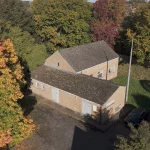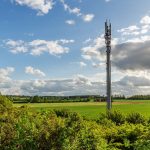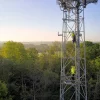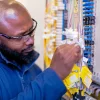Openreach Builds FTTP Broadband to 18.3 Million UK Premises

National network access provider Openreach (BT) has confirmed that their Fibre-to-the-Premises (FTTP) network, which offers broadband speeds of up to 1800Mbps to UK homes via hundreds of ISPs, has now covered 18.3 million UK premises (Ready for Service). This is now growing at a rate of 1.1 million premises (RFS) per quarter.
The official data shows that the operator’s FTTP network alone can now reach 55% of UK premises (out of 33 million total premises), which at country-level changes to 50% in England, 50% in Scotland, 67% in Wales and a whopping 90% in Northern Ireland where they’ve always been fairly strong.
The operator is currently investing up to £15bn to expand the coverage of this full fibre network to reach 25 million UK premises by December 2026 (here), which includes around 6.2 million premises in rural or semi-rural areas. On top of that, they’ve also expressed an ambition to reach up to 30 million by the “end of 2030“, although this is partly dependent upon a favourable outcome from Ofcom’s next Telecoms Access Review 2026 (note: it looks like they’ll get what they want on this).
Advertisement
Openreach currently has 15,000 people focused on their full fibre deployment and the average per premises build cost continues to hover around the £280 mark or roughly £1.2bn per year. The new service, once live, can be ordered via various ISPs, such as BT, Sky Broadband, TalkTalk, Vodafone and many more (Openreach FTTP ISP Choices) – it is not currently an automatic upgrade, although some providers have started to do free automatic upgrades as older copper-based services and lines are slowly withdrawn.
One catch in all this is that Openreach did lose 707,000 broadband lines to rivals during 2024 and some analysts expect this to accelerate in 2025 (here). But most of those losses continue to come from areas where they’ve yet to deploy FTTP (i.e. those covered by copper-based solutions, such as ADSL or FTTC / VDSL2), which is why the operator’s strategy is to “build as fast as we can to fill in those areas“, said CEO Clive Selley to Richard Tang of Zen Internet (here).
Mark is a professional technology writer, IT consultant and computer engineer from Dorset (England), he also founded ISPreview in 1999 and enjoys analysing the latest telecoms and broadband developments. Find me on X (Twitter), Mastodon, Facebook, BlueSky, Threads.net and Linkedin.
« Ofcom Blasts NOW and TalkTalk for UK Broadband Complaints – Q4 2024





















































I suspect that many that left for Alt Nets will likely be for one of two reasons (or both): 1) Lower cost and/or 2) Symmetric Download/Upload speeds. I know if I had the choice of a 1000/1000 package (heck, 500/500 would be fine) I would much rather have that then the asymmetric I have now with Openreach.
As the article says most of the losses are where Openreach has yet to build FTTP, I suspect most people leaving Openreach for an altnet in areas that they have built are leaving for cost reasons rather than the lack of asymmetric.
i think you will find it is because they cannot offer fttp in those areas yet . Price and upload speeds will play a part for some but the bulk of it will be because there is no Openreach arability
Think most people would be happier with anything that isn’t ADSL tbh. Symmetrical uploads is something most people will never actually need.
I omitted part of my comment that said if you have/had a choice. @Ed a faster upload is brilliant if you have larger files to upload or lots to do. I recently had to upload over 200GB and a faster upload would have been brilliant.
Our family and friends are not signing up with BT based ISP BECAUSE it’s not symmetric. Signed up to ALTNETS.
“Our family and friends are not signing up with BT based ISP BECAUSE it’s not symmetric. Signed up to ALTNETS.”
I assume you meant “Openreach based ISP”.
Even if this anecdote is true, is it because they did their own research and decided that symmetric is for them, or is it because they have a family member or friend going on about how they absolutely need it when they actually don’t? Or is it because the altnet happens to be cheaper and coincidentally offers symmetric service?
I’d happily forego symmetric if it meant retaining a quality service with a quality provider. I value not having to deal with CGNAT or dodgy routing far more than slightly faster uploads. NB before the usual accusation is levied – I don’t necessarily mean a BT Group ISP.
Of course you can have both downsides. An altnet is sadly polluting the streets around my parent’s place. I think they use XGS equipment but are not offering symmetric residential service. Sadly no Openreach FTTP yet. I wonder what the altnet fans think of that?
I did not want to go to FTTP, I was fine with FTTC, but Plusnet just pushed and pushed, the price was more for something I did not want, they were also intent on a 24-month contract.
I had a leaflet though the door about the alt net, they were offering 12-month contract, the price was lower than what Plusnet was offering for FTTP, in fact the price the altnet was offering was the same price I was paying for FTTC.
I thought, well if I am being forced to FTTp, I may was well go with someone who was offering a 12month contract and in theory has a better network than Openreach. It was a good move, so far.
i did look at onestream for FTTC as they had a 12-month contract and the price was good.
I will never go into a 24 month contract again, NEVER.
I don’t even have fttc, = 16mb down, and 1up.
A village just outside of Bath, truespeed did 30% of the village and they are not coming back.
Openreach are asleep here.
OR busy elsewhere. They will probably get round to you. You need to complain that none of the other companies have installed outside you.
An i’m a compact commuter town 30 miles from London.
Nearby towns done years ago, BT have just added us by end 26.
They work from spreadsheets and projections, not people complaining.
Part of what slows down areas is if new transformers are needed as fttp uses alot more power. This is more applicable to rural areas. I know several that had to wait for new transformers before any cabling was done.
This shows how much of a backwards company BT Openreach truly is! It is 2025, and so far they have only managed to cover 55% of the country. Full fibre should have been around everywhere more than a decade ago. How on earth did this country managed to build a copper-based nationwide telecom service in the past? Why aren’t they able anymore to build a new fibre network? This has been a Can’t Do culture for too long!
seeing as openreach are adding 4 million premises per year for the last few years, not sure where only comes from. no doubt 10 years ago, no one wanted to pull the trigger on a 15billion build plan and who would have thought 10 years ago 30mb or less wouldnt be enough speed. wouldnt even have got this far is there wasnt govt upto 5bn contracts etc ( which dont think was avaialbale 10 years ago either ) . ps im on 30mb and works perfectly fine for 99% of what i need it to do, only thing wouldnt do is sky stream and downloading a 10gb update would take hours rather than minutes for example
BT sweated copper pure and simple. Only when ALTNETS came along and regulation over PIA did BT change its tune. Unlike the ALTNETS though, they continue to deploy legacy GPON kit that will take them a decade to upgrade later, even if new kit is GPON and XGS-PON capable. They have endless trials and end up knee capping capability anyway. BT thought fttc was wonderful, and that nobody needed fttp as was too expensive and Fttc was fast enough.
@anonymous that’s not true. It was a government decision made in 1990 that forced BT’s hand and gave us the legacy where we are today. https://www.techradar.com/news/world-of-tech/how-the-uk-lost-the-broadband-race-in-1990-1224784
@Steve: The reality about this Thatcher decision is more nuanced than this single narrative suggests. While it is true that the Thatcher government emphasized competition in the telecommunications sector, the idea that a single decision in 1990 entirely stopped a nationwide BT fibre deployment is an oversimplification. Nobody has prevented BT from deploying fibre for more than two decades now.
An XGS-PON upgrade, when it becomes required commercially (i.e. when a significant proportion of ordinary people want to take speeds >1Gbps) will take months, not decades.
The fibre in the ground doesn’t have to change, just the equipment in the exchanges. It doesn’t even require going round changing all the customer ONTs, since GPON and XGS-PON run in parallel on the same fibre.
But since equipment is replaced in cycles anyway, it will probably piggy-back on one of those cycles.
>>” How on earth did this country managed to build a copper-based nationwide telecom service in the past? Why aren’t they able anymore to build a new fibre network? This has been a Can’t Do culture for too long!”<<
@GNewton The BT national fibre network build is being done far quicker than the national copper network build which started in the late 1800s and took until the 1960s to reach 35% takeup.
Ne555 read my statement again. BT take ages to do anything, whether kit is capable or not. Then it gets to a stage where it’s taken do long, it’s well and truly supseded.
Just ONE example. FTTC, had capability gor lower SNR target to give higher sync to customers. A technology known as PhyRE and also better VDSL profile that reduced crosstalk impact. PhyRE only got deployed to Huawei cabinets and profile 35 never got done. They simply took so long, that FTTP superseded the effort. Those customers on FTTC have seen lines get worse and worse with noise now. The ECI cabs had initial issue, but they just sat on it…
PHY-R didn’t work properly on ECI hardware. ECI couldn’t fix it. Needed software in place for Huawei DSLAMs and all the supported CPE.
The lower SNR margin risked increasing the fault rate. Their CPs needed to be asking for it and needed both a need and testing. 6dB had been standard for DSL for a decade and more.
Vectoring required service board upgrades, new vectoring cards to handle the calculations and if multiple chassis present cross-connects on Huawei chassis. ECI DSLAMs it required an entirely new chassis.
Profile 35b required all chassis serving the area to be the same manufacturer and all vectoring, new line cards and those requirements were why G.fast was used instead: it could run alongside unvectored VDSL.
None of this stuff was just flick a switch and everything is awesome.
You’re complaining about them being too slow to do things, widespread vectoring, 35b, they didn’t intend to do.
Still no sign of openreach fibre in my town of 10000. Got nexfibre (plus some patchy trooli/giganet i cant get) just over a year ago and and anyone who cares has moved over already. To be honest if virgin media wasn’t so flaky I’d not even be looking for openreach now…
It’s been great travelling in Malaysia recently, with fast fibre everywhere. Now, we’re back in southern England in the ancient world of asymmetric copper. But my wife encountered a fibre contracting van (Complete Telecom) in our road yesterday and actually talked to them – yes, they’re working for Openreach, and things are finally, finally stirring!
1.1M a quarter at that cost point is quite remarkable – putting aside arguments it’s years too late.
Ah yes, the “build as fast as we can” approach.
Translated based on their deployment so far around here…. let’s skip all the flats and call it done.
Let’s see how long it takes VM to pull fiber to all the new cabs they installed throughout April and if that’ll incentivise Openreach.
Re skipping flats, this may help explain why.
https://www.ispreview.co.uk/index.php/2025/05/inca-criticise-openreach-for-approach-to-fttp-in-uk-flats-renters-rights-bill.html
A Full Fibre install is becoming mandatory in certain areas as part of the digital voice rollout.
adsl areas? as DV works perfectly fine on sogea, mother has it on her 30mb broadband and no issues at all ( no full fibre in the area )
I guess I am odd then because I have 300/50 with BT and 2Gbps with Brsk – I would like a backup as often Brsk goes down – and it’s something like £82 a month for both which is a bargain
Brsk goes down? Have you tried to find out why they go down?
If my broadband went down often, I would want to know why, certainly as it is my only broadband band I am paying for that service.
I know some people on Faceache have complained about Zzoomm, but for me, it has been faultless apart from the first few weeks, A lot of the problem with Zzoomm is their awful router and the Wi-Fi on it. i say to people to buy a cheap TP-link router as it will do a better job.
You need to get Brsk to sort out the problem.
Brsk is netomnia and netomnia have had a bad few weeks for outages lasting hours. I’m assuming brsk is now integrated into netomnia network.
Member of the family was new with them and within a couple of weeks of each other, two big outages that lasted 12 hours+. Good thing was they emailed admitting a service issue, bad thing is that youfibre or netomnia don’t have a service status page on their Web site. Really bad.
Other than that though, the symmetric service is great speeds all the time, just need to concentrate on stability. Hopefully, this was a blip. All operators suffer outages, it’s just whether the quantity over a year is single hand figures or more. As TV moves to be delivered by IP all ISPs need to get tgeur act together.
@anonymous,
I see,
you are right, all ISPs can have outages, as I said above, my provider did when I first started using it and I thought why did i change, should have stayed as i was or moved to another FTTC provider. Someone have decided to cut a main trunk fibre, and it slowed everything down. But after that, all was fine and no problems since.
I hope netomnia can sort out reliability
“ I know some people on Faceache have complained about Zzoomm, but for me, it has been faultless apart from the first few weeks, A lot of the problem with Zzoomm is their awful router and the Wi-Fi on it. i say to people to buy a cheap TP-link router as it will do a better job.”
So, er, very much not faultless then?
There are still places in London that have no fibre at all.
There are places all over the country that don’t have fibre.
London is large, so there are bound to be some places that don;t have fibre.
I see fibre on poles from both front and back windows but not to the poles on my street. Bt say we are too far away and no plans. Yet the first 5 houses connected to a different exchange have fibre 8mb download with upto 1mb upload so currently forced to use 5G broadband.